

 |
Diversity At A Glance (pdf)
This column aims to introduce interesting species of Hong Kong flora and fauna that might be encountered during fieldwork. Distinctive physical characteristics and some interesting ecological facts are included for each example. If you wish to contribute to this column, or have any comments or suggestions, please contact eitherJacqueline Weir (jesweir@hkusua.hku.hk) or Sukh Mantel (skmantel@hkusua.hku.hk)
|
|
|
|
|
|
|
|
'The six common Bauhinia species in Hong Kong'
The flower of Bauhinia blakeana was adopted as the emblem of Hong Kong in 1965. The tree was first discovered on the shore of Hong Kong Island near Pokfulam around 1880 and described as a new species in 1908 by Dunn. It was named after Hong Kong governor Sir Henry Blake, who had a strong interest in botany. Fruit set is extremely rare in B. blakeana, as it is of hybrid origin.
There are six common Bauhinia species in Hong Kong, which can be separated into two groups, the tree species (subgenus Bauhinia) and the liana species (subgenus Phanera). Bauhinia blakeana, B. purpurea and B. variegata var. variegata are trees that are widely cultivated and distributed in different areas in Hong Kong, from roadsides to local and country parks. The tree species are exotics, originally from Guangdong province and Malaysia. The three Bauhinia tree species can be distinguished by their petal colours, number of stamens, flowering periods and fruit sets. Bauhinia blakeana produces fragrant flowers that have five rose-purple petals with darker veins and whitish towards the margins, and each flower has five pink fertile stamens. The colour of B. purpurea flowers is highly variable ranging from pale pink to violet. They have three fertile stamens, or rarely four. The petals of B. variegata var. variegata are purple, streaked with red and yellow. They have the same number of stamens as B. blakeana. Bauhinia variegata var. candida is a variety of B. variegata var. variegata. Its petals are white streaked with yellow and green veins.
Flowering period differs slightly for each species. Bauhinia purpurea blooms first, from September to January; B. blakeana blooms second and has the longest flowering season (8-10 months) from September to April-June; B. variegata blooms from late December to April.
Bauhinia corymbosa, B. championii, and B. glauca are liana species, the latter two being native. They grow on hillsides and stream-sides as natural populations in Hong Kong, such as in Aberdeen Country Park, Victoria Road, Bowan Road and Tai Po Road. Bauhinia corymbosa flowers first in late spring, followed by B. glauca in early summer, and then by B. championii in late summer. The liana species have smaller flowers than the tree species, and many small flowers cluster together to form inflorescences. Bauhinia championii has white to cream colour flowers. The petals of B. corymbosa and B. glauca are white with pink lines. Bauhinia corymbosa has smaller petals - the upper petal overlaps the lateral petals - and the deep pink colour of the androecium and gynoecium distinguish it from B. glauca. Bauhinia glauca is much more common than B. corymbosa in Hong Kong. It produces dense inflorescences which fragrance the hillsides. The flowering periods of these two species are coming - try to identify the two species by the characteristics described above and learn something new about them.
 |
| Fig. 1. Bauhinia blakeana |
|
|
P.8 |
|
Porcupine! |
 Copyright © 2000 |